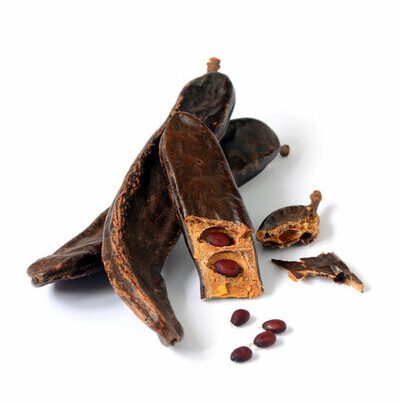
Locust Bean
Also known as carob seed
What is Locust Bean?
Locust bean (LB) is the seed of the carob tree. Its flour or gum is used as a thickener, fat replacer, dough conditioner, stabilizing agent and cocoa powder substitute.1 Locust bean gum helps with formulating low-calorie and gluten-free bakery products by partially replacing wheat flour.
- Structurally, locust bean gum is very similar to guar
- It is typically used in combination with xanthan gum
Chemical Formula

Origin
Locust or carob tree (Ceratonia siliqua) is an evergreen ancient tree from Mediterranean origin. Today, these beans are mainly harvested from Morocco, Spain, Italy, and other mediterranean countries.1
Locust bean gum (LBG) is a galactomannan, a linear polysaccharide consisting of ß-(1-4) – mannose backbone with a single D-galactopyranosyl unit attached via α-(1-6) linkage. LBG is characterized by its low galactose content (~20%) compared to other galactomannans like guar gum and tara gum.1
Function
Locust bean gum (LBG) has several functions in bakery systems:1
- Thickener: increases the viscosity of batters.
- Fat replacer: LBG can mimic the mouthfeel of fats in baked goods due to their high water holding capacity.
- Dough conditioner: aids in the production of doughs with constant functional properties.
- Stabilizing agent: aids in shelf life extension.
- Texturizer: improves rheological properties and produces a softer crumb.
- Cocoa powder substitute: LBG powder may be used to substitute cocoa powder in some recipes.
- Moisture retention aid
Nutrition
LBG has the following chemical composition:1
It doesn’t contribute to daily caloric intake due to the negligible quantities added to baked products.
Commercial production
This bean powder is produced by grinding roasted pods and followed by these steps:1
- Kibbling: the seeds and pulp are separated by kibbling the carob pods.
- Dehusking: husk is removed from the seeds by mechanical or chemical means. Locust bean seeds are treated with a dilution of sulfuric acid at high temperatures and later washed and brushed.
- Drying: peeled kernels are dried to the appropriate moisture content.
- Cracking and sifting: dried kernels are cracked and the germ portion is removed from the endosperm.
- Milling: endosperm is ground to the required particle size
- Packaging
Application
LBG is used in several applications in the food industry such as: films and coatings, noodles, ice cream, dairy products, dressings and sauces, and bakery products.
In bakery products, locust bean gum may have the following effects:1,2
- Higher yields of baked products: reduces the use of eggs and fats.
- Improves the final texture and dough rheology: produces a softer crumb in breads.
- Better machinability of cookies when combined with guar gum.
- Extends product shelf life.
- Improves gluten-free bakery products texture, providing products with improved loaf volume and crumb texture.
- Improves stability of pie fillings and meringues.
- Produces softer cakes and cookies.
- Aids in cake pan removal.
- LBG can be used as a substitute for cocoa powder.
Regulations
Locust bean gum is considered GRAS by the FDA when used as stabilizing and thickening agents, and for its fat replacement properties.1
In the EU, locust bean gum (E 410) is considered a safe food additive according to EU Commission Regulation (EU) No 231/2012 .3
References
- Barak, Sheweta, and Deepak Mudgil. “Locust bean gum: Processing, properties, and food applications—A review.” International journal of biological macromolecules 66 (2014): 74-80.
- Figoni, P. How Baking Works: Exploring The Fundamentals Of Baking Science. 2nd ed., John Wiley & Sons, Inc., 2008.
- EFSA Panel on Food Additives Nutrient Sources added to Food (ANS), et al. “Re‐evaluation of locust bean gum (E 410) as a food additive.” Efsa Journal 15.1 (2017): e04646.

